Related Research Articles

Felidae is a family of mammals in the order Carnivora, colloquially referred to as cats, and constitutes a clade. A member of this family is also called a felid. The term "cat" refers both to felids in general and specifically to the domestic cat.

A mineral is, broadly speaking, a solid chemical compound that occurs naturally in pure form. Minerals are most commonly associated with rocks due to the presence of minerals within rocks. These rocks may consist of one type of mineral, or may be an aggregate of two or more different types of minerals, spacially segregated into distinct phases. Compounds that occur only in living beings are usually excluded, but some minerals are often biogenic or are organic compounds in the sense of chemistry. Moreover, living beings often synthesize inorganic minerals that also occur in rocks.

Stoichiometry is the calculation of reactants and products in chemical reactions.
Panthera is a genus within the family Felidae that was named and described by Lorenz Oken in 1816 who placed all the spotted cats in this group. Reginald Innes Pocock revised the classification of this genus in 1916 as comprising the species lion, tiger, jaguar, and leopard on the basis of common cranial features. Results of genetic analysis indicate that the snow leopard also belongs to the Panthera, a classification that was accepted by IUCN Red List assessors in 2008.

Trout is the common name for a number of species of freshwater fish belonging to the genera Oncorhynchus, Salmo and Salvelinus, all of the subfamily Salmoninae of the family Salmonidae. The word trout is also used as part of the name of some non-salmonid fish such as Cynoscion nebulosus, the spotted seatrout or speckled trout.

In biology, extinction is the termination of a kind of organism or of a group of kinds (taxon), usually a species. The moment of extinction is generally considered to be the death of the last individual of the species, although the capacity to breed and recover may have been lost before this point. Because a species' potential range may be very large, determining this moment is difficult, and is usually done retrospectively. This difficulty leads to phenomena such as Lazarus taxa, where a species presumed extinct abruptly "reappears" after a period of apparent absence.

Redox is a type of chemical reaction in which the oxidation states of atoms are changed. Redox reactions are characterized by the transfer of electrons between chemical species, most often with one species undergoing oxidation while another species undergoes reduction. The chemical species from which the electron is stripped is said to have been oxidized, while the chemical species to which the electron is added is said to have been reduced. In other words:

In chemistry, an oxidizing agent is a substance that has the ability to oxidize other substances — in other words to accept their electrons. Common oxidizing agents are oxygen, hydrogen peroxide and the halogens.
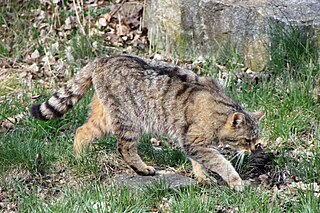
Felis is a genus of small and medium-sized cat Felinae species native to most of Africa and south of 60° latitude in Europe and Asia to Indochina. The genus includes the domestic cat. The smallest Felis species is the black-footed cat with a head and body length from 38 to 42 cm. The largest is the jungle cat with a head and body length from 62 to 76 cm.
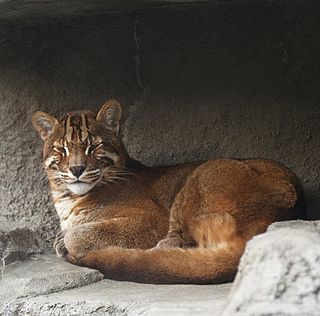
Catopuma is a genus containing two Asian small wild cat species, the Asian golden cat and the bay cat . Both are typically reddish brown in colour, with darker markings on the head.

The Dall sheep, also known as the thinhorn sheep, is a species of wild sheep native to northwestern North America, ranging from white to slate brown in colour and having curved, yellowish-brown horns. The two subspecies are the nominate Dall sheep or Dall's sheep and the more southern subspecies, Stone sheep, which is a slate brown with some white patches on the rump and inside the hind legs.

Ornithomimus is a genus of ornithomimid dinosaurs from the Late Cretaceous Period of what is now North America. Ornithomimus was a swift bipedal theropod which fossil evidence indicates was covered in feathers, equipped with a small toothless beak that may indicate an omnivorous diet. It is usually classified into two species: the type species, Ornithomimus velox, and a referred species, Ornithomimus edmontonicus. O. velox was named in 1890 by Othniel Charles Marsh on the basis of a foot and partial hand from the late Maastrichtian-age Denver Formation of Colorado, United States. Another seventeen species have been named since, though most of them have subsequently been assigned to new genera or shown to be not directly related to Ornithomimus velox. The best material of species still considered part of the genus has been found in Alberta, Canada, representing the species O. edmontonicus, known from several skeletons from the early Maastrichtian Horseshoe Canyon Formation. Additional species and specimens from other formations are sometimes classified as Ornithomimus, such as Ornithomimus samueli from the earlier, Campanian-age Dinosaur Park Formation of Alberta.
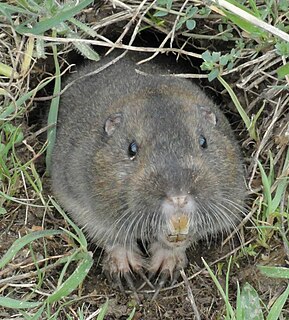
Pocket gophers, commonly referred to as just gophers, are burrowing rodents of the family Geomyidae. There are about 35 species, all endemic to North and Central America. They are commonly known for their extensive tunneling activities and their ability to destroy farms and gardens.

Oryzomys couesi, also known as Coues' rice rat, is a semiaquatic rodent in the family Cricetidae occurring from southernmost Texas through Mexico and Central America into northwestern Colombia. It is usually found in wet habitats, such as marshes, but also lives in drier forests and shrublands. Weighing about 43 to 82 g, O. couesi is a medium-sized to large rat. The coarse fur is buff to reddish above and white to buff below. The hindfeet show some specializations for life in the water, such as reduced ungual tufts of hair around the digits. It has 56 chromosomes. There is much geographic variation in size, proportions, color, and skull features. Oryzomys couesi is active during the night and builds nests of vegetation that are suspended among reeds about 1 m (3.3 ft) above the ground. It is an excellent swimmer and dives well, but can also climb in vegetation. An omnivore, it eats both plant and animal food, including seeds and insects. It breeds throughout the year; females give birth to about four young after a pregnancy of 21 to 28 days. The species may be infected by several different parasites and by two hantaviruses.
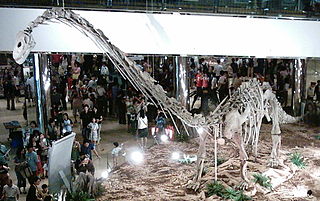
Omeisaurus is a genus of sauropod dinosaur from the Middle Jurassic Period of what is now China. Its name comes from Mount Emei, where it was discovered in the lower Shaximiao Formation of Sichuan Province.

Sociality is the degree to which individuals in an animal population tend to associate in social groups (gregariousness) and form cooperative societies.

The Mutisioideae are a subfamily in the plant family Asteraceae that includes about 630 species assigned to 44 different genera. This subfamily is mainly native in South America, except for Adenocaulon, Chaptalia, Gerbera, Trichocline, which have species in all continents other than Europe and Antarctica. Common characters are the deeply incised corollas of the disc florets, with five lobes, sometimes merged in two lips, flower heads with overlapping involucral bracts, anthers with tails and pointy tips, the styles usually stick far out of the florets and are essentially hairless. Most species are herbs, but some are vines, shrubs, or small trees.

Cathayornis is a genus of enantiornithean birds from the Jiufotang Formation of Liaoning, People's Republic of China. It is known definitively from only one species, Cathayornis yandica, one of the first Enantiornithes found in China. Several additional species were once incorrectly classified as Cathayornis, and have since been reclassified or regarded as nomina dubia.
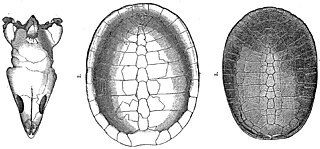
Glyptops is an extinct genus of cryptodire turtle dating from the Late Jurassic and Early Cretaceous periods 155 to 99 m.y.a. Fossils have been found in South Dakota, Wyoming, Colorado, Utah, New Mexico, Oklahoma, and Texas from both the Morrison and Cedar Mountain formations. The type species is G. plicatulus, which had been named Compsemys plicatulus by Edward Drinker Cope.

The Onoserideae are a tribe of flowering plants in the sunflower family, Asteraceae.
References
- 1 2 3 Flann, C (ed) 2009+ Global Compositae Checklist
- ↑ Philippi, Rudolf Amandus. 1860. Florula Atacamensis seu Enumeriatio 27
- ↑ Tropicos, Gypothamnium Phil.
- ↑ Zuloaga, F. O., O. Morrone, M. J. Belgrano, C. Marticorena & E. Marchesi. (eds.) 2008. Catálogo de las plantas vasculares del Cono Sur. Monographs in systematic botany from the Missouri Botanical Garden 107(1–3): i–xcvi, 1–3348.
| This Asteraceae-related article is a stub. You can help Wikipedia by expanding it. |